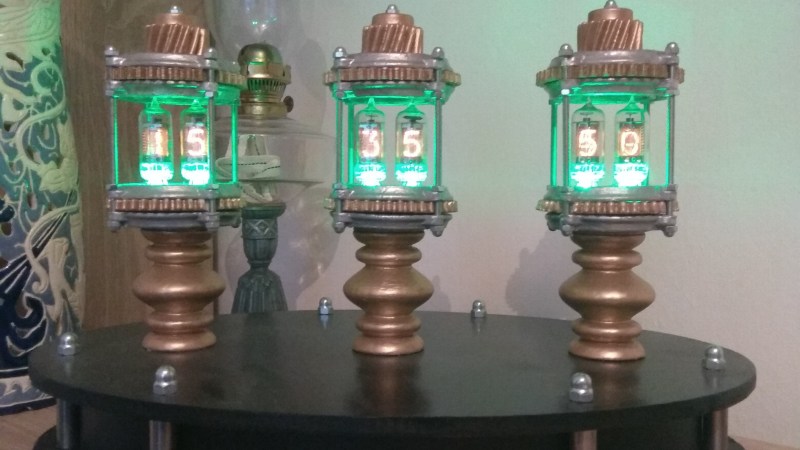[Ioszelos] built a nixie clock with a dizzying array of features.
Do you ever wish that you could log in to your clock from your phone and turn off your TV? We assume that [Ioszelos] did. The clock can also play MP3s and stream radio stations. It can record the indoor temperature, humidity, and barometric pressure. Did we mention it’s an FM radio too? We’re not sure, but we wouldn’t be surprised if there was a faucet hiding somewhere on the contraption.
A team effort shared between an ESP32 and Mega 2560 run the Rube Goldberg-like show. Custom boards were spun up to provide the control and voltages needed for the nixie tubes. The clock is constructed from machined plates and 3D printed files.
It all comes together in a steampunk reminiscent assembly. The glow from the RGB leds and nixie tubes combine to make an interesting visual effect. We’ve certainly never seen a clock quite like it before.



















I’d assume this would be something like what you’d get if you got Pratchett’s Discworld’s Bloody Stupid Johnson to make a smart watch.
Ooops, that may come across as an insult, the BS part was half that he had no sense of scale, as this is too large to strap on a wrist, and half that he implemented wacky and dangerous features in his otherwise genius designs.
Say no to LED’s under nixies!
Totally agree ! Putting blue leds under nixies or other tubes should be banned ;) It completely negates the visual effect of vacuum tubes. Of course it is possible to hide led-ruined nixies inside closed box and display the time on a fancy lcd or transmit the time to the android app. Or maybe i’m just too old.
Makes me want to build a nixie clock with colored incandescents under the nixies…
Hopefully there’s at least a way to turn the leds off in software.
Came to the comments just to say this. If you’re going to cover it in LEDs anyway, you might as well just use a picture of a nixie on an OLED.
If you want to do gears theme, make everything mechanical. Don’t make anything half ass.
Nothing more distracting and visually distracting than mixing EVERY technology like some cheesy props.
I get the aesthetic of the green LEDs – gives it that healthful radium glow that hints at the true nature of the power source here… unlicensed nuclear power sources.
brass, nixie, gears.. I feel this deserve the needed:
https://www.youtube.com/watch?v=TFCuE5rHbPA
It seems that Nixie-like display tubes weren’t actually invented (or at least patented) until the 1930s, a decade after the first CRTs, which is arguably the “late Dieselpunk” era (which I’ll assert ended with the first atomic bomb detonation or fully electronic digital computer.) That said, technologically, it seems like something that could have been built by a suitably skilled craftsperson as soon as osmium, tantalum, or tungsten filament bulbs were invented (1898, 1902, and 1904, respectively).